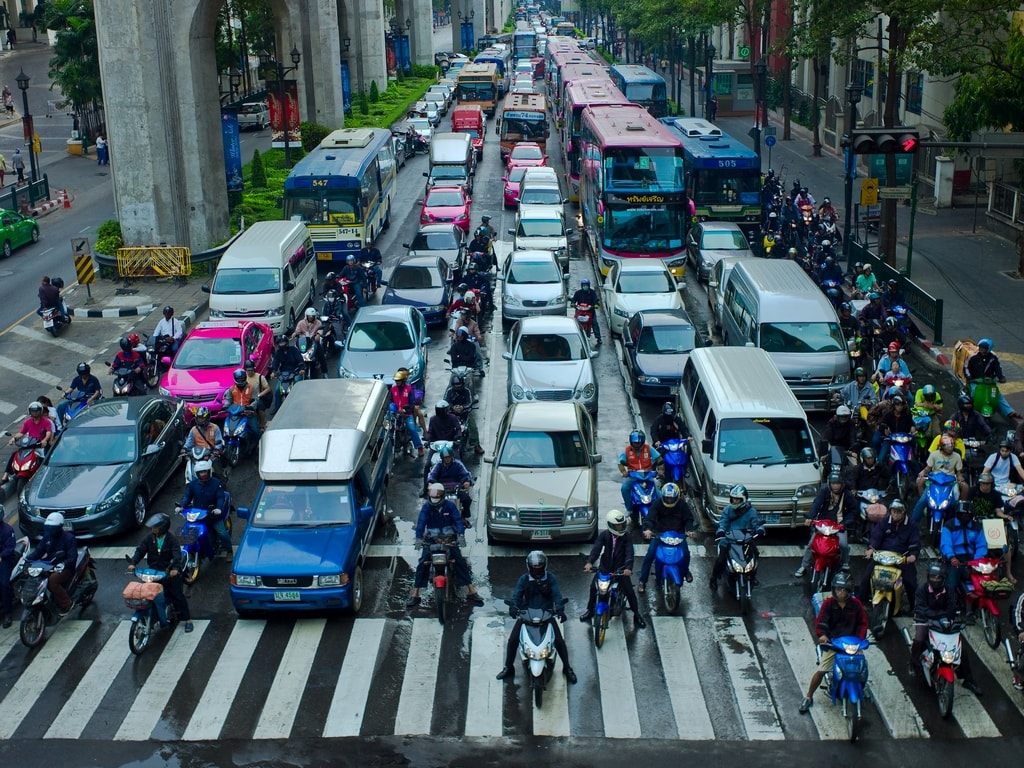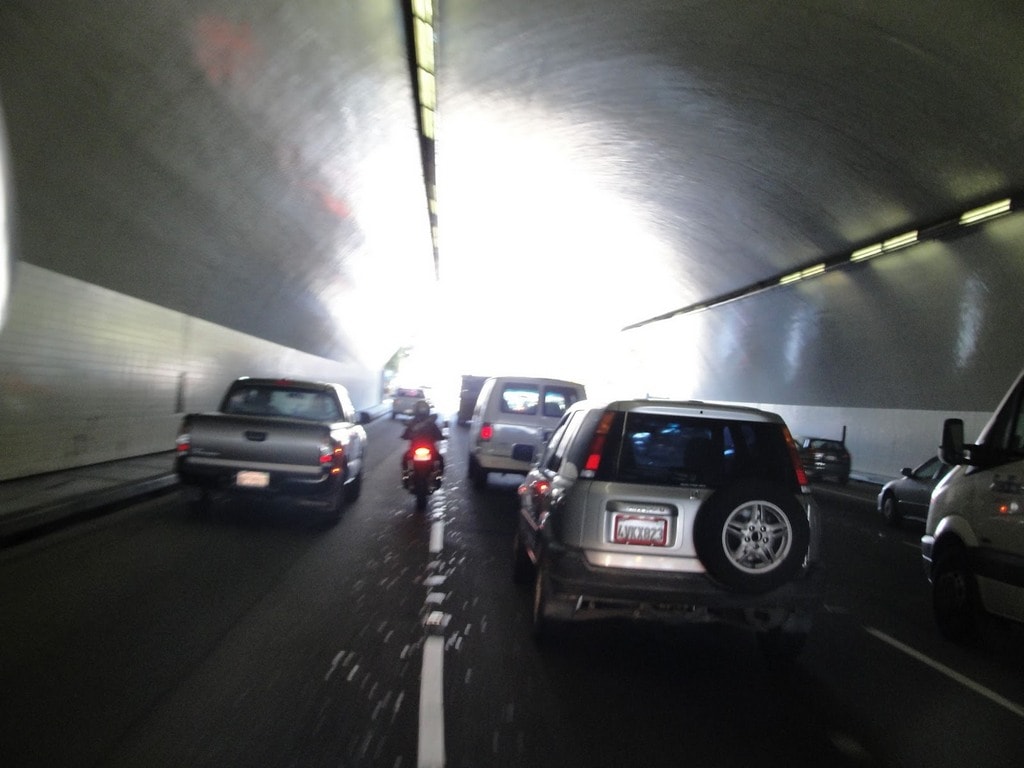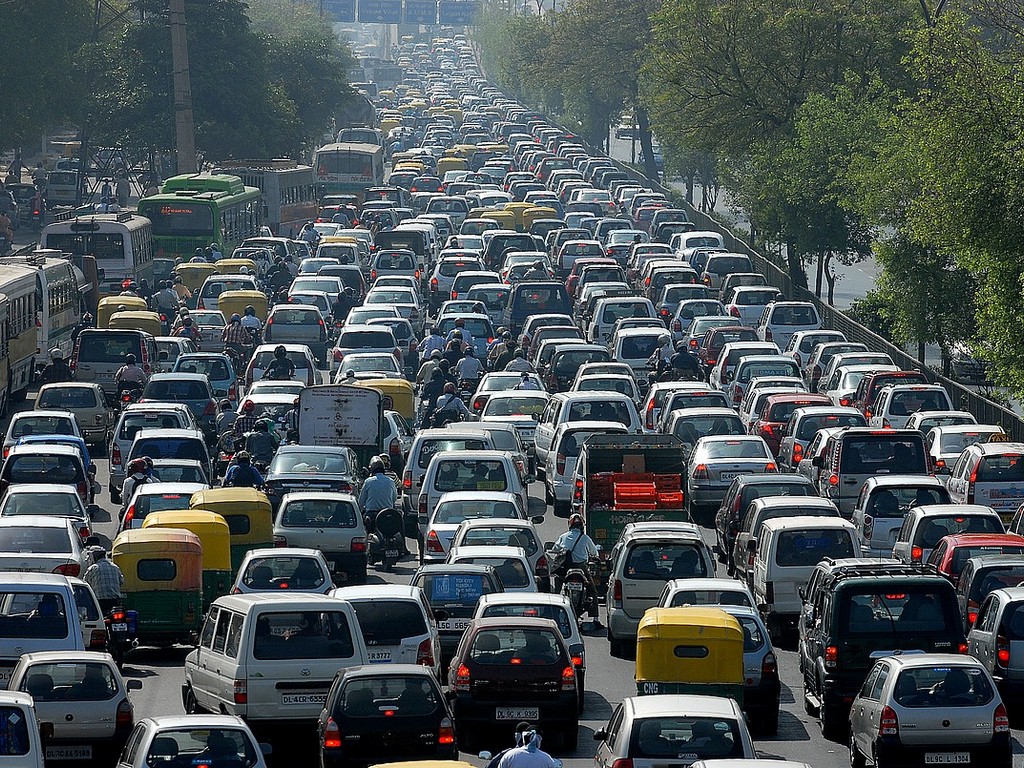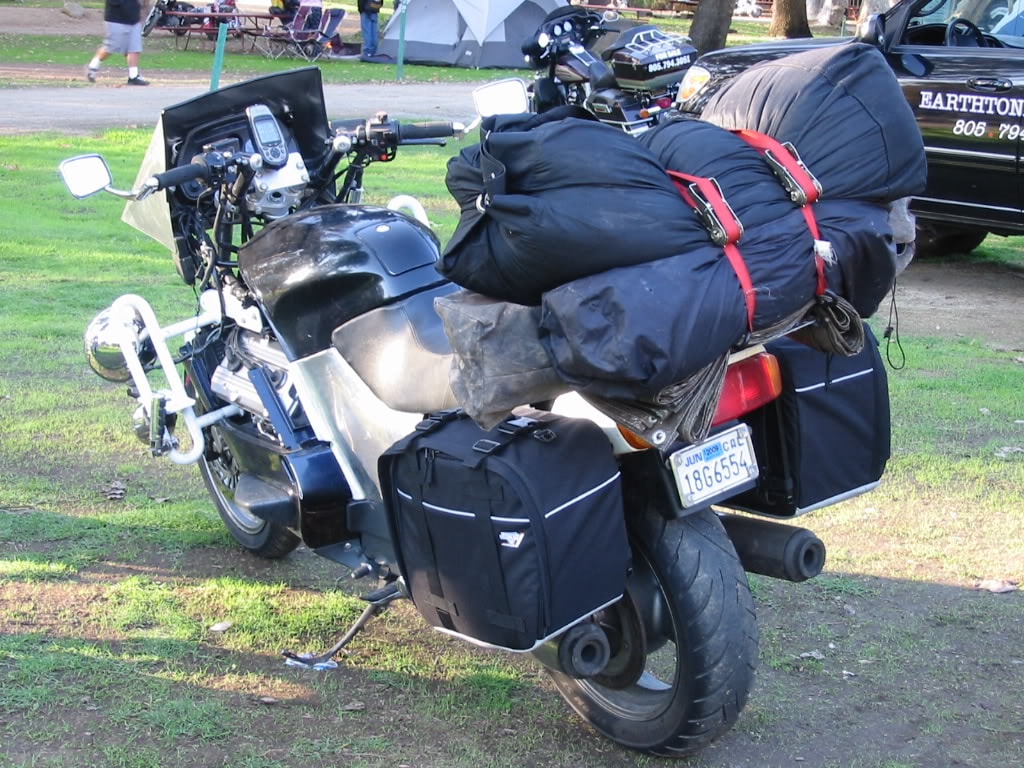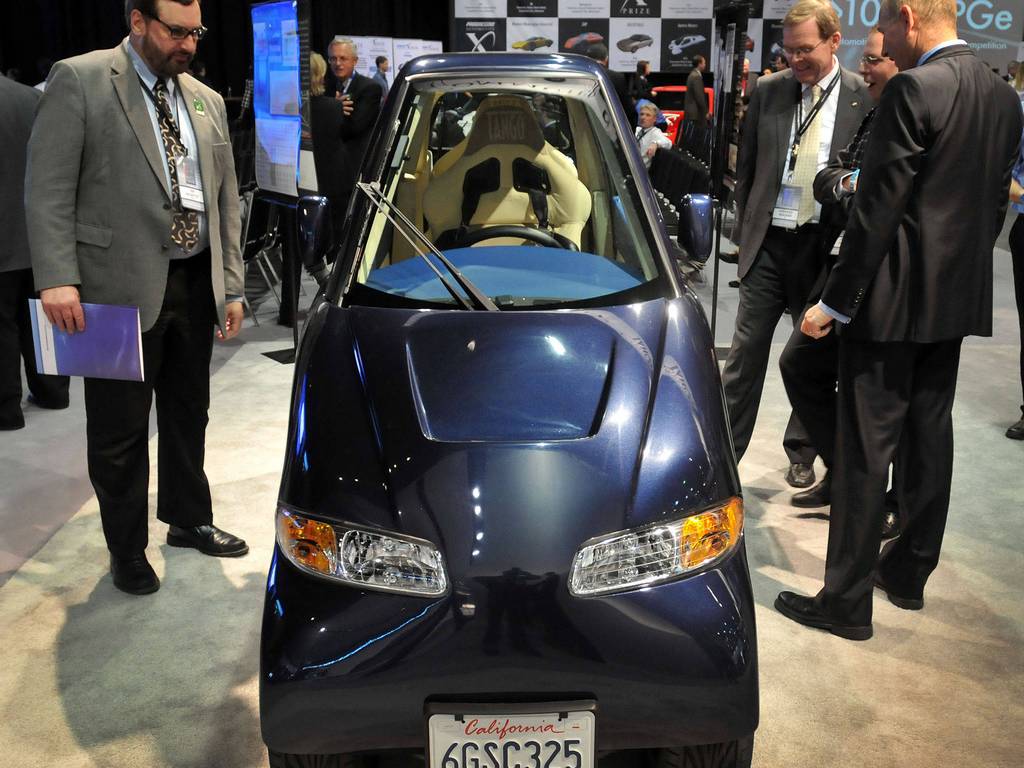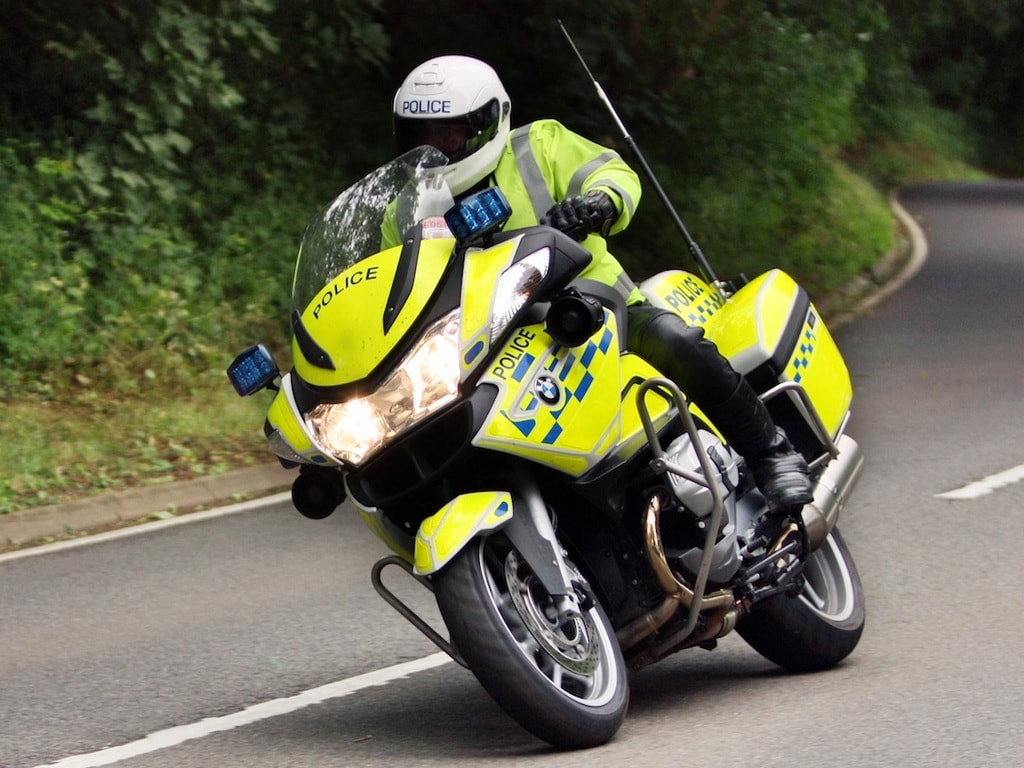Hello, fellow riders, and welcome to another episode in our cover story dedicated to motorcycle myths. So far we've discussed the noise and the helmet issues, and we've explained why riders prefer black leather garments or why braking hard as long as possible is preferable to jumping off the bike.
On lane splitting
The next topic in our endeavor to shed more light on some of the motorcycle-specific aspects brings us to one of the most controversial subjects: lane splitting. If need be, lane splitting could be defined as operating a motorcycle between two adjacent lanes of traffic on a public road.
Lane splitting is a maneuver used by motorcyclists to overtake other vehicles especially in heavy traffic, by literally passing between two rows of cars, often riding exactly over the separation lines, be they white or yellow, single or double, continuous or not.
We should note that lane splitting differs a lot from lane sharing. Splitting refers to riding between two traffic lanes, whereas sharing means to overtake a vehicle by passing beside it within the space of the lane both vehicles are in. With a lot of drivers and even riders who would fail to sense the difference between these two, such a remark seems to be most welcome, to say the least.
Far from judging upon right or wrong as far as laws are concerned, we must also add that there are a lot of countries where even lane sharing is prohibited, even for motorcycles. While police motorcycles are allowed to share lanes during an emergency, other riders are not allowed to do so. Anyway, the acceptance of lane sharing is wider than that of lane splitting.
Why lane sharing is believed to be a dangerous thing remains to be discussed; bikers are usually very alert when traveling in a larger company and most of them are careful to maintain their position in the group, no matter if they're traveling at high speeds or just cruising, straight lane or while cornering.
Lane splitting is also referred to as “filtering” because looking at traffic jams with motorcycles slowly passing between cars resembles quite much to the way smaller objects pass through a filter. In places, filtering is even forbidden when the cars have come to a complete stop, no matter whether we're thinking about traffic lights or a jam.
Depending on your luck (and local law), if a cop sees you “filtering” towards the front of the car group you might end up in trouble, with a ticket or even fined. Try to take a look around you before lane splitting - it might save you some trouble.
A final consideration upon this matter must be made: motorcycles are entitled to full use of a lane and driving another motor vehicle in such a manner “as to deprive any motorcycle of the full use of a lane” is forbidden. The quote comes from the NY State Vehicle and Traffic Law, section 1252. However, the same law states that two motorcycles can be operated “abreast in a single lane”, yet “a motorcycle shall not overtake and pass in the same lane occupied by the vehicle being overtaken.”
Present day roads tend to get very crowded during rush hours, during the morning or afternoon and sometimes these heavy traffic hours can extend quite a lot. Riding a bike comes with certain advantages when taking into account the smaller dimensions of the vehicle and the ease with which one can “squeeze” through crowded areas or stuck cars.
A lot of car drivers will admit (in their hour of complete honesty) that seeing a bike passing them by and disappearing between the cars in the front is frustrating at times. On the other hand, most riders would admit that they tend to feel frustration when cars are stopped a bit too closer one to each other, just enough to prevent the passing of a motorbike.
It's common sense that the smaller the vehicle you're driving or riding, the easier you'll find a way to squeeze through the slow traffic or make it to the front of the halted line, but not everybody is willing to accept this. That's why we've all met - some of us with nasty consequences - the ill-willed car driver who closes the passing space for bikes or even worse – the reckless guys who change lanes or open doors without prior checking. Thus, an even higher state of alert is required when splitting lanes, and this brings us to the technical matters.
One of the first things one should stress when discussing this matter with the “angry driver type” is the fact that such a way to ride a bike in heavy traffic is total madness. Driving between the lanes means a lot more exposure to potential dangers by itself alone, and doing so at a high speed is more like asking for something bad to happen. And since limiting one's exposure to dangerous situations is a key element for making it home safely, one does not have to be a genius to figure out how things work.
Lane splitting at high speed is a truly dangerous maneuver and a lot of things can go wrong. First of all comes the small amount of time and distance available to make a decision in case another vehicle behaves in an unexpected manner. Even more, riders should also consider the limited lateral available space, a matter that leaves little room for mistakes and misjudging.
One of the most common opinions about the ideal speed when splitting lanes is that 10-15 mph (~16-24 kph) above the speed of the other vehicles in traffic is acceptable, while doing more than 20 mph (~32 kph) over the traffic speed is just “asking for it”. While this maneuver is most commonly carried out at fairly low speed, most riders agree that one should not try splitting lanes if riding above 35 mph (~56 kph). Moreover, if you're riding a sidecar or a touring bike with large panniers, maybe splitting lanes is not the best idea you can come up with.
In slow traffic, car drivers may become less alert and take fewer looks in the mirrors, thus significantly decreasing their chances to see you. Revving up the engine a bit when getting between the lanes and firing up the high beam, even using the horn with moderation are effective ways to be noticed by car drivers.
Using one's brain while lane splitting and making sure the drivers in the cars in front have acknowledged the incoming bike are mandatory; it's no rocket science, but failing to obey these common sense rules might put a rider in serious peril. Safety in such scenarios is not determined by the loudness of the pipes or yellow neon helmet, but by speed, common sense and some skill.
On the other hand, swerving continuously across multiple lanes and swiping the entire width of the road/ highway will make car drivers/ most other fellow riders angry and a cop less hesitant to fine you for reckless driving.
Before detailing statistical data, it's again the common sense that should make things clear. When it comes to fatal bike accidents in crowded traffic lanes, rear-end collisions are by far the most commonly met: either an oncoming vehicle impacts a motorcycle from the rear, or a rider rear-ends a slower/ halted car.
This means that the entire impact energy is being split between the two colliding vehicles and thus substantial damage ensues in most cases. Despite the slower speed and the fact that the colliding vehicles are moving in the same direction, rear-end impacts are more like head-on collisions: the impulse transferred causes large-scale damage to both vehicles and the motorcyclist is often thrown off his/ her bike, suffering various types of injuries.
Side collisions, though occurring in larger numbers, end up without being even reported to the police, because they usually cause minor damage. Even more, chances are that a rider could still remain in the bike after a “side knock”, with little to no damage at all, save for a serious scare and some verbal abuse.
Even when stopped in a highway jam, most riders would recommend positioning the bike between the lanes. It's simply safer in case a careless driver fails to notice the halted cars in front of him/ her and rear-ends the first ones stopped. The domino effect will send other vehicles forward out of control and it's way better not to be caught between the hammer and the anvil in such an unfortunate scenario.
Data can be accessed here and the charts show quite well that California has a lower rate of motorcycle fatalities caused by rear-end crashed, with bikes hitting cars or the other way around. Comparison has been made with Arizona, Florida, Texas and the US average data and the numbers show a lower percentage of rear-end motorcycle deaths among all-vehicle rear-end fatalities in California.
When comparing the number of fatalities caused by bikes rear-ending other vehicles in California with other states, one can see that Cali has fewer deaths. The striking difference is when judging the deaths occurring when a motorcycle is the one being hit: California has almost 50% less fatalities of this kind. Though still arguable, this fact could be attributed to the lane splitting-permissive law in California.
Without being able to claim we've “busted” this myth, some facts cannot be denied: lane splitting should only be done at low speeds, with high awareness and making as sure as possible the other drivers notice you.
In case you're passing on the right side (or left side in the UK), you should know that such a thing comes with the risk of the driver steering right/ left without any turning signal and crash directly into you.
And one final thing for the frustrated car drivers: if you let the bike pass, it will quickly be out of the jam and on its way, meaning one less vehicle in front of you. We're not filtering in disdain or in your spite: we're doing this because we're thinner and we can squeeze through.
Read more about motorcycle myths below:
Most Common Motorcycle Myths Debunked: Part 4
Most Common Motorcycle Myths Debunked: Part 3
Most Common Motorcycle Myths Debunked: Part 2
Most Common Motorcycle Myths Debunked: Part 1
The next topic in our endeavor to shed more light on some of the motorcycle-specific aspects brings us to one of the most controversial subjects: lane splitting. If need be, lane splitting could be defined as operating a motorcycle between two adjacent lanes of traffic on a public road.
Lane splitting is a maneuver used by motorcyclists to overtake other vehicles especially in heavy traffic, by literally passing between two rows of cars, often riding exactly over the separation lines, be they white or yellow, single or double, continuous or not.
We should note that lane splitting differs a lot from lane sharing. Splitting refers to riding between two traffic lanes, whereas sharing means to overtake a vehicle by passing beside it within the space of the lane both vehicles are in. With a lot of drivers and even riders who would fail to sense the difference between these two, such a remark seems to be most welcome, to say the least.
Legal matters
In most countries and states lane splitting is an illegal maneuver. As far as the US are concerned, California is the only state where lane splitting is legal. There may be other countries around the world where lane splitting is allowed, but the generic opinion on this matter is that such a move should be illegal.Far from judging upon right or wrong as far as laws are concerned, we must also add that there are a lot of countries where even lane sharing is prohibited, even for motorcycles. While police motorcycles are allowed to share lanes during an emergency, other riders are not allowed to do so. Anyway, the acceptance of lane sharing is wider than that of lane splitting.
Why lane sharing is believed to be a dangerous thing remains to be discussed; bikers are usually very alert when traveling in a larger company and most of them are careful to maintain their position in the group, no matter if they're traveling at high speeds or just cruising, straight lane or while cornering.
Lane splitting is also referred to as “filtering” because looking at traffic jams with motorcycles slowly passing between cars resembles quite much to the way smaller objects pass through a filter. In places, filtering is even forbidden when the cars have come to a complete stop, no matter whether we're thinking about traffic lights or a jam.
Depending on your luck (and local law), if a cop sees you “filtering” towards the front of the car group you might end up in trouble, with a ticket or even fined. Try to take a look around you before lane splitting - it might save you some trouble.
A final consideration upon this matter must be made: motorcycles are entitled to full use of a lane and driving another motor vehicle in such a manner “as to deprive any motorcycle of the full use of a lane” is forbidden. The quote comes from the NY State Vehicle and Traffic Law, section 1252. However, the same law states that two motorcycles can be operated “abreast in a single lane”, yet “a motorcycle shall not overtake and pass in the same lane occupied by the vehicle being overtaken.”
Why would you split lanes?
I've heard this (rather silly) question so many times already, and I know you've heard it too. The answer is as obvious as it may seem illogical for those who haven't gotten it from the very beginning. It's not a race between motorcycles and cars/ trucks: it's the very existence of a possibility to get to your destination easier and a bit sooner.Present day roads tend to get very crowded during rush hours, during the morning or afternoon and sometimes these heavy traffic hours can extend quite a lot. Riding a bike comes with certain advantages when taking into account the smaller dimensions of the vehicle and the ease with which one can “squeeze” through crowded areas or stuck cars.
A lot of car drivers will admit (in their hour of complete honesty) that seeing a bike passing them by and disappearing between the cars in the front is frustrating at times. On the other hand, most riders would admit that they tend to feel frustration when cars are stopped a bit too closer one to each other, just enough to prevent the passing of a motorbike.
It's common sense that the smaller the vehicle you're driving or riding, the easier you'll find a way to squeeze through the slow traffic or make it to the front of the halted line, but not everybody is willing to accept this. That's why we've all met - some of us with nasty consequences - the ill-willed car driver who closes the passing space for bikes or even worse – the reckless guys who change lanes or open doors without prior checking. Thus, an even higher state of alert is required when splitting lanes, and this brings us to the technical matters.
When and how?
Most car drivers and other non-driving folk might become very nervous when lane splitting is brought into discussion, and most of these angry guys will mention those “low fliers” speeding between rows of cars and of whom many end up dead.One of the first things one should stress when discussing this matter with the “angry driver type” is the fact that such a way to ride a bike in heavy traffic is total madness. Driving between the lanes means a lot more exposure to potential dangers by itself alone, and doing so at a high speed is more like asking for something bad to happen. And since limiting one's exposure to dangerous situations is a key element for making it home safely, one does not have to be a genius to figure out how things work.
Lane splitting at high speed is a truly dangerous maneuver and a lot of things can go wrong. First of all comes the small amount of time and distance available to make a decision in case another vehicle behaves in an unexpected manner. Even more, riders should also consider the limited lateral available space, a matter that leaves little room for mistakes and misjudging.
One of the most common opinions about the ideal speed when splitting lanes is that 10-15 mph (~16-24 kph) above the speed of the other vehicles in traffic is acceptable, while doing more than 20 mph (~32 kph) over the traffic speed is just “asking for it”. While this maneuver is most commonly carried out at fairly low speed, most riders agree that one should not try splitting lanes if riding above 35 mph (~56 kph). Moreover, if you're riding a sidecar or a touring bike with large panniers, maybe splitting lanes is not the best idea you can come up with.
In slow traffic, car drivers may become less alert and take fewer looks in the mirrors, thus significantly decreasing their chances to see you. Revving up the engine a bit when getting between the lanes and firing up the high beam, even using the horn with moderation are effective ways to be noticed by car drivers.
Using one's brain while lane splitting and making sure the drivers in the cars in front have acknowledged the incoming bike are mandatory; it's no rocket science, but failing to obey these common sense rules might put a rider in serious peril. Safety in such scenarios is not determined by the loudness of the pipes or yellow neon helmet, but by speed, common sense and some skill.
On the other hand, swerving continuously across multiple lanes and swiping the entire width of the road/ highway will make car drivers/ most other fellow riders angry and a cop less hesitant to fine you for reckless driving.
Is splitting better that keeping in line?
Funny or not, data shows that in case of a collision when in a line of vehicles, being between the rows comes with a lot more chances to avoid massive injuries and death altogether.Before detailing statistical data, it's again the common sense that should make things clear. When it comes to fatal bike accidents in crowded traffic lanes, rear-end collisions are by far the most commonly met: either an oncoming vehicle impacts a motorcycle from the rear, or a rider rear-ends a slower/ halted car.
This means that the entire impact energy is being split between the two colliding vehicles and thus substantial damage ensues in most cases. Despite the slower speed and the fact that the colliding vehicles are moving in the same direction, rear-end impacts are more like head-on collisions: the impulse transferred causes large-scale damage to both vehicles and the motorcyclist is often thrown off his/ her bike, suffering various types of injuries.
Side collisions, though occurring in larger numbers, end up without being even reported to the police, because they usually cause minor damage. Even more, chances are that a rider could still remain in the bike after a “side knock”, with little to no damage at all, save for a serious scare and some verbal abuse.
Even when stopped in a highway jam, most riders would recommend positioning the bike between the lanes. It's simply safer in case a careless driver fails to notice the halted cars in front of him/ her and rear-ends the first ones stopped. The domino effect will send other vehicles forward out of control and it's way better not to be caught between the hammer and the anvil in such an unfortunate scenario.
Some statistic facts on lane splitting
Since California is the only American state allowing lane splitting, it's obvious that studies have been carried out with Cali statistical data in comparison with what's going on in other states and with the US average. We'll bring forth a study assembled by Steve Guderian using official US DOT(United States Department of Transportation), NHTSA (National Highway Traffic Safety Administration) or the Oregon DOT.Data can be accessed here and the charts show quite well that California has a lower rate of motorcycle fatalities caused by rear-end crashed, with bikes hitting cars or the other way around. Comparison has been made with Arizona, Florida, Texas and the US average data and the numbers show a lower percentage of rear-end motorcycle deaths among all-vehicle rear-end fatalities in California.
When comparing the number of fatalities caused by bikes rear-ending other vehicles in California with other states, one can see that Cali has fewer deaths. The striking difference is when judging the deaths occurring when a motorcycle is the one being hit: California has almost 50% less fatalities of this kind. Though still arguable, this fact could be attributed to the lane splitting-permissive law in California.
The end?
Far from being over, the lane-splitting topic has its supporters and opponents, in both riders' and state law regulation communities. Mostly due to the laws, lane splitting is still considered an unwholesome maneuver in ANY scenario, but those who ride daily can come up with even more evidence to support the lobby for making it legal.Without being able to claim we've “busted” this myth, some facts cannot be denied: lane splitting should only be done at low speeds, with high awareness and making as sure as possible the other drivers notice you.
In case you're passing on the right side (or left side in the UK), you should know that such a thing comes with the risk of the driver steering right/ left without any turning signal and crash directly into you.
And one final thing for the frustrated car drivers: if you let the bike pass, it will quickly be out of the jam and on its way, meaning one less vehicle in front of you. We're not filtering in disdain or in your spite: we're doing this because we're thinner and we can squeeze through.
Read more about motorcycle myths below:
Most Common Motorcycle Myths Debunked: Part 4
Most Common Motorcycle Myths Debunked: Part 3
Most Common Motorcycle Myths Debunked: Part 2
Most Common Motorcycle Myths Debunked: Part 1
